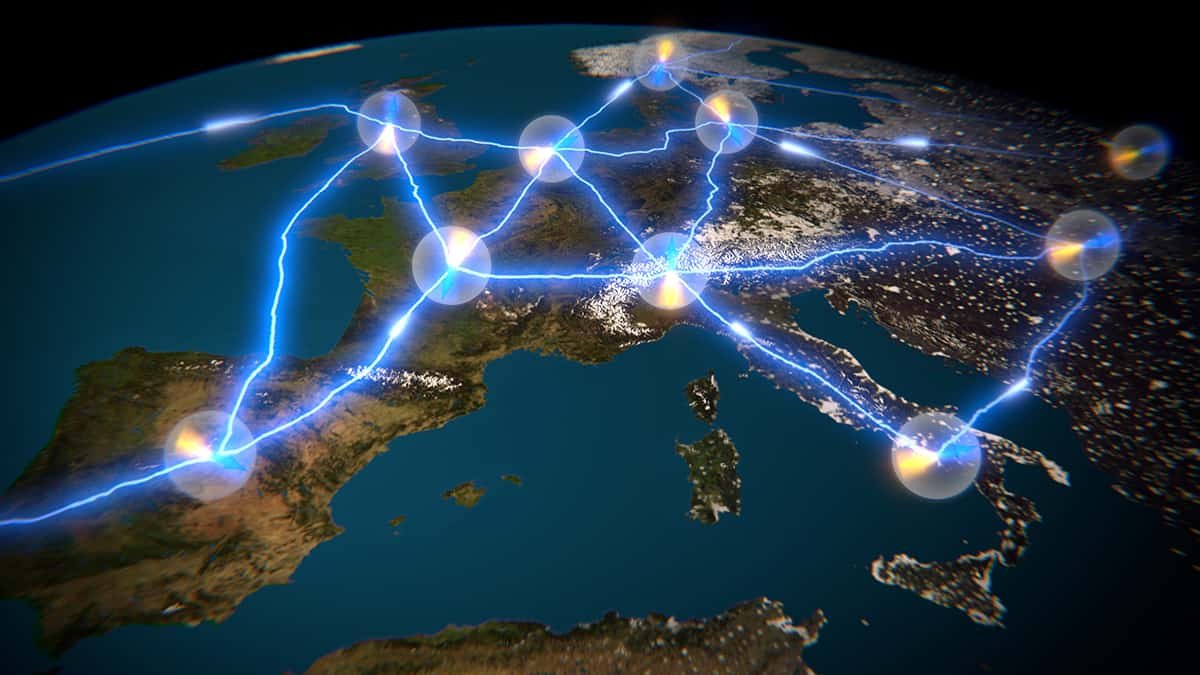



Our current research program aims to develop:
Scalable, fault-tolerant universal quantum computers with ultrafast clock speeds at room temperature
Chip-scale quantum-enhanced sensing and spectroscopy systems
All-optical quantum networks with hybrid systems
Large-scale quantum simulators with continuous-variable systems
-

Quantum Computation and Quantum Simulation
Optical photons offer many critical scalability benefits, including the ability to perform quantum operations at room temperature, ultrafast clock speeds, compatibility with telecommunication technology, and the ease of networking modular quantum processing units to build large-scale systems for practical quantum advantages. Over the years, tabletop experiments have shown the promise of photonic quantum information processing, as exemplified by the generation of large-scale entangled states and long-distance quantum teleportation networks.
Our research focuses on harnessing all-optical nonlinearities in nanophotonics to develop quantum information systems operating at room temperature for computation and simulation applications. (Image: Sayo Studio)
-

Quantum-enhanced Sensing and Metrology
A prominent application of photonics is quantum-enhanced detection to surpass the quantum shot-noise limit (SNL) in optical measurements. Such techniques, for instance, provide sensitivity and precision beyond the SNL for detecting microscopic fluctuations in physical parameters such as position, as demonstrated in LIGO. The central idea behind these techniques is to imprint the unknown physical quantity onto the sub-shot-noise observables of quantum states of light, followed by optimal measurements to attain precision bounded by the quantum Fisher information.
Our goal is to develop novel quantum light sources, operations, and measurement techniques to achieve sensitivity performance approaching to the ultimate Heisenberg limit. (Image: DARPA)
-

Quantum Networks for Distributed Quantum Processors
In the near future, large-scale quantum information processors will likely require many quantum processing units (QPUs) linked to one another. Efficient and robust quantum networks will play an essential role in coherently transferring quantum information between QPUs with high fidelity and at ultrafast rates.
Our objective is to develop all-optical quantum networks leveraging optical nonlinearity for generating, routing, and measuring quantum states of light, thereby enabling information transfer across the entire THz bandwidth of optical fields. Additionally, we are interested in interfacing these networks with matter-based qubit platforms to enable distributed computing and sensing applications. (Image: Physics World)
Publications
— 2024
All-optical measurement-device-free feedforward enabling ultra-fast quantum information processing, T. Yamashima, T. Kashiwazaki, T. Suzuki, R. Nehra, T. Nakamura, A. Inoue, T. Umeki, K. Takase, W. Asavanant, M. Endo, A. Furusawa (arXiv:2410.20693)
Ultrafast single-photon detection using nanophotonic parametric amplifiers, E. Sendonaris, J. Williams, Rajveer Nehra, R. Gray, R. Sekine, L. Ledezma, A. Marandi (arXiv: 2410.18397)
All-optical Loss-tolerant Distributed Quantum Sensing, R. Nehra, C. Oh, L. Jiang, and A. Marandi (arXiv:2407.13654)
Optically-Sampled Superconducting-Nanostrip Photon-Number Resolving Detector for Non-Classical Quantum State Generation, M. Endo, K.Takahashi, T. Nomura, T. Sonoyama, Masahiro Yabuno, S. Miki, H. Terai, T. Kashiwazaki, A.Inoue, T. Umeki, R.Nehra, K. Takase, W. Asavanant, A. Furusawa (arXiv:2405.06901)
High-rate Generation and State Tomography of Non-Gaussian Quantum States for Ultra-fast Clock Frequency Quantum Processors, A. Kawasaki, R. Ide, H. Brunel, Takumi Suzuki, R. Nehra, K. Nakashima, T. Kashiwazaki, A. Inoue, T. Umeki, F. China, M. Yabuno, S. Miki, H. Terai, T. Yamashima, A. Sakaguchi, K. Takase, M. Endo, W. Asavanant, A. Furusawa (Nature Communications 15: 9075 (2024)
Ultra-Short Pulse Biphoton Source in Lithium Niobate Nanophotonics at 2 um, J. Williams, R. Nehra, E. Sendonaris, L. Ledezma, R. M. Gray, R. Sekine, and Alireza Marandi, (Nanophotonics -2024-0054)
— 2023
Mesoscopic ultrafast nonlinear optics -- The emergence of multimode quantum non-Gaussian physics, R. Yanagimoto, E. Ng, M. Jankowski, R. Nehra, T. P. McKenna, T. Onodera, L. G. Wright, R. Hamerly, A. Marandi, MM Fejer, H. Mabuchi , Optica 11, 7, 896-918 (2024)
Octave-spanning tunable parametric oscillation in nanophotonics, L. Ledezma, A. Roy, L. Costa, R. Sekine, R. Gray, Q. Guo, R. Nehra, R. M. Briggs, A. Marandi, (Science Advances, arXiv: 2203.11482)
Engineering cubic quantum nondemolition Hamiltonian with mesoscopic optical parametric interactions, R. Yanagimoto*, R. Nehra* , E. Ng, A. Marandi, and H. Mabuchi,
Quantum Nondemolition Measurements with Optical Parametric Amplifiers for Ultrafast Universal Quantum Information Processing, R. Yanagimoto*, R. Nehra*, R. Hamerly, E. Ng, A. Marandi, and H. Mabuchi (PRX Quantum 4, 010333)
Non-equilibrium spectral phase transitions in coupled nonlinear optical resonators, A. Roy, R. Nehra, C. Langrock, M. Fejer, and A. Marandi, (Nature Physics 19, 427–434 (2023)
— 2022:
Few-cycle vacuum squeezing in nanophotonics, R. Nehra*, R. Sekine*, L. Ledezma, Q. Guo, R. M. Gray, A. Roy, and A. Marandi, (Science, 377, 6612, 1333-1337)
Femtojoule femtosecond all-optical switching in lithium niobate nanophotonics, Q. Guo*, R. Sekine*, L. Ledezma*, R. Nehra, D. J. Dean, A. Roy, R. M. Gray, S. Jahani, and A. Marandi,
All-optical ultrafast ReLU function for energy-efficient nanophotonic deep learning, G. H.Y. Li*, R. Sekine*, R. Nehra*, R. M. Gray*, L. Ledezma, Q. Guo, and A. Marandi,
Intense optical parametric amplification in dispersion-engineered nanophotonic lithium niobate waveguides, L. Ledezma*, R. Sekine*, Q. Guo*, R. Nehra, S. Jahani, and A. Marandi,
Topological optical parametric oscillation, A. Roy, C. Leefmans, R. Nehra, M. Parto, and A. Marandi, (Nanophotonics-2021-0765)
Temporal walk-off induced dissipative quadratic solitons, A. Roy, R. Nehra, S. Jahani, L. Ledezma, C. Langrock, M. Fejer, and A. Marandi, (Nature Photonics 16, pages 162–168)
— 2021:
All-optical Quantum State Engineering for Rotation-symmetric Bosonic States, R. Nehra, M. Eaton, O. Pfister, and A. Marandi (arXiv: 2105.11035)
Heisenberg-limited quantum interferometry with multiphoton-subtracted twin beams, M. Eaton, R. Nehra, A. Win, and O. Pfister, (Phys. Rev. A 103, 013726)
— 2020:
Characterizing quantum detectors by Wigner functions, R. Nehra* and K. V. Jacob*, (arXiv: 1909.10628)
Photon-number-resolving segmented detectors based on single-photon avalanche-photodiodes, R. Nehra, C. Chang, Q. Yu, A. Beling, and O. Pfister, (Optics Express, 28,
— 2019:
Non-Gaussian and Gottesman–Kitaev–Preskill state preparation by photon catalysis, M. Eaton, R. Nehra, O. Pfister, (New Journal of Physics 21 (11), 113034)
State-independent quantum state tomography by photon-number-resolving measurements, R. Nehra, A. Win, M. Eaton, R. Shahrokhshahi, N. Sridhar, T. Gerrits, A. Lita, and O. Pfister,
*: Equal contribution. A complete updated list can be found at my Google Scholar.
Our sponsors


